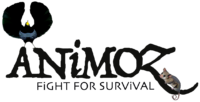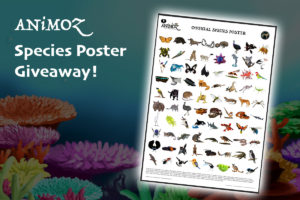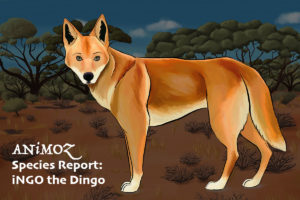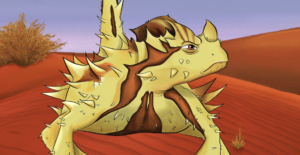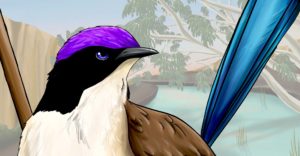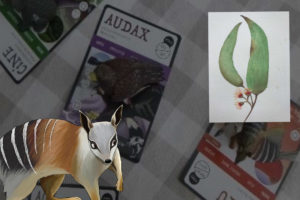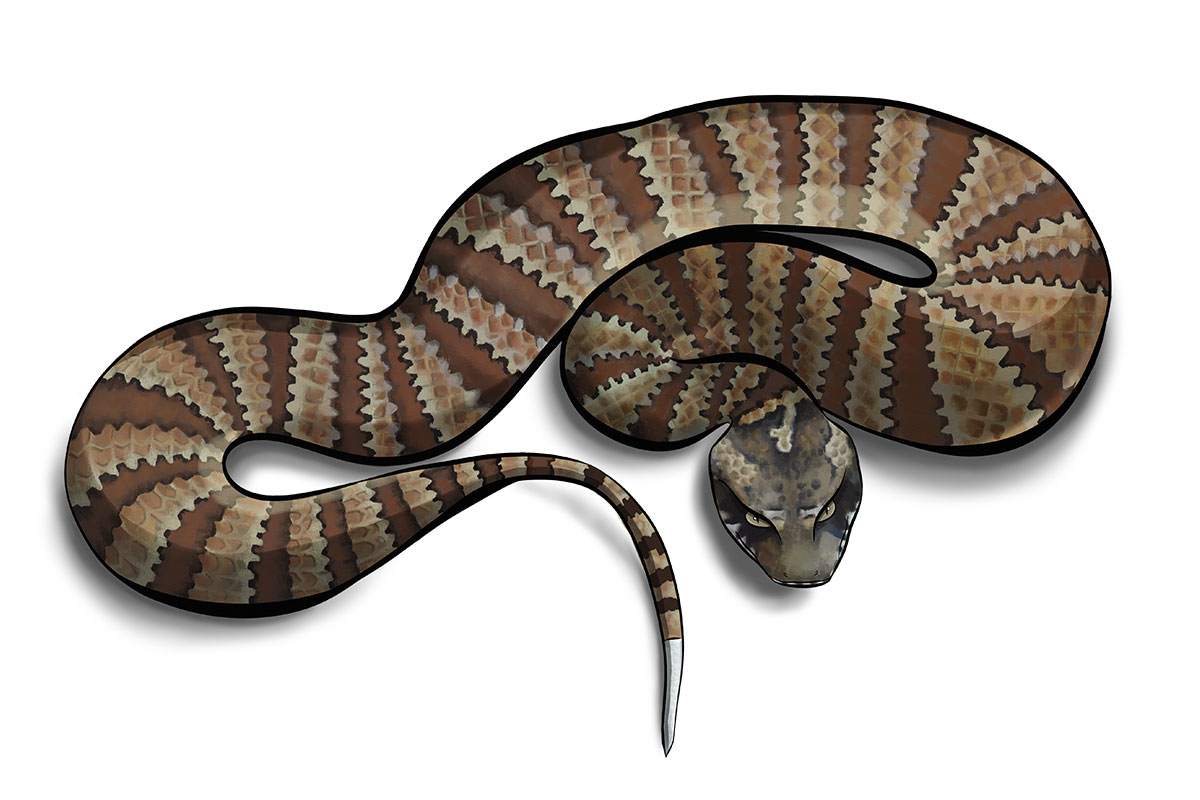
ANTAR - Common Death Adder
“There is little noise aside from the crashing waves near this coastal woodland, and all is still apart from the flutter of birds. Having not moved from under this pile of leaves in over a day, ANTAR is showing extreme patience as she awaits the perfect moment to strike. With just the tip of her tail sticking out, her Leaf N Lure Power is working its magic. Wing species, seeing this tasty snack wiggling about on the forest floor, are coming closer and closer. Finally, one can no longer resist. EXiMi swoops in to grab lunch, but the leaves explode and ANTAR’s big, arrow-like head opens and grabs hold of her prey. Her Muscle Lock Power kicks in, and she begins her feast...”
ANiMOZ #110
Code: ANTAR
Common name: Common Death Adder
Taxonomy: Acanthophis antarcticus
Level: CARN | Form: VENOM | Status: COMMON
BiOME: COAST + Scrub
Overcomes: Drought
Superpowers:
MUSCLE LOCK
ANTAR’s deadly venom works predominantly as a neurotoxin, meaning her victim gradually loses control of their muscles! Her Muscle Lock Superpower isn’t always engaged, often biting threats with a ‘dry bite’ without releasing any venom. This is because it takes a lot of energy for ANTAR to produce the toxin. However, when needed, she will lock down her prey’s muscles, eventually leading to their death!
LEAF N LURE
Being a cryptic species, ANTAR uses his Leaf N Lure power to hide amongst leaves and draw his prey toward him, unsuspecting. His tail tip is shaped like a worm, so whilst lying under the cover of fallen leaves, ANTAR slowly writhes his tail back and forth. This movement attracts hungry animals who aren’t prepared for a sudden explosion of leaves and the surprising attack!
Weaknesses:
WING
Whilst ANTAR sometimes feeds on smaller birds, she automatically loses a Clash with a Wing species due to her vulnerability to aerial attack. NOVA is a constant threat, as are many other larger birds. They don’t always see ANTAR as a food item though - they may just be protecting their nest, mistakenly thinking ANTAR would predate their eggs!
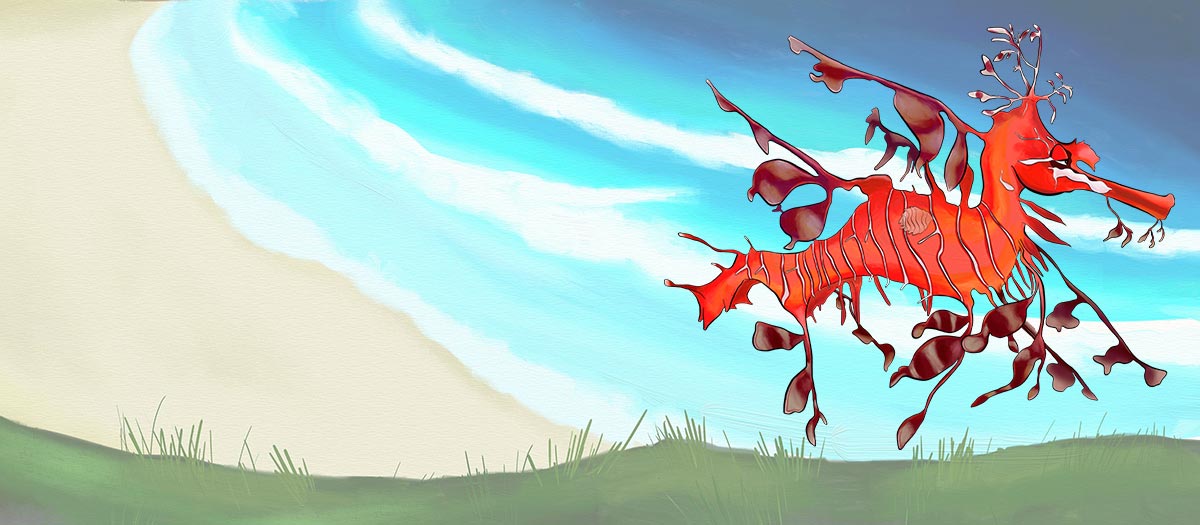

Booster Packs for Kids in Need
This December, you can help us bring a smile to kids who are facing challenging times. For every Booster Pack sold this month, we will donate a separate Booster Pack to the Backpacks 4 SA Kids organisation to gift as a present to a child in need. As we enter the festive season for 2022, …
Species Report: RiNU the Eastern Quoll
The Eastern Quoll (Dasyurus viverrinus) is RiNU! RiNU come in two colour morphs: dark and fawn. A litter of RiNU can include both colours! RiNU was once found across eastern Australia but is now restricted to Tasmania. RiNU are nocturnal, hunting alone at night. About the Eastern Quoll Though she be but little, she is …
Official Species Poster Giveaway!
Win 1 of 5 giant Species Posters featuring every ANiMOZ species! As an ANiMOZ Ranger, your job is to learn as much as you can about Australian wildlife, and work to protect our many endangered animals. So to help you fully appreciate all the different species that make up the World of ANiMOZ, we’re giving …
Species Report: OLi the Red Handfish
The Red Handfish (Thymichthys politus) is OLi – the world’s rarest fish! The Red Handfish is found in only two small patches of reef in south-eastern Tasmania There are only around 100 adult OLi left in the wild! They are so rare that scientists will not disclose where their second population is to prevent poaching …
Species Report: iNGO the Dingo
The Australian Dingo (Canis lupus dingo) is iNGO – an Apex Predator from the ANiMOZ Scrub BiOME! iNGO arrived in Australia on boats with Indonesian seafarers sometime between 8000-4000 years ago and are most closely related to the New Guinea Singing Dog They live in family groups and are an important part of the ecosystems …
From the Field: Ranger Zali talks about iNGO!
From the Field: Headquarters speaks to real-life Rangers working to save ANiMOZ species like iNGO the Dingo! In our From the Field series, we talk to people working across Australia to save the many animals you know from the World of ANiMOZ. Today, we hear from Ranger Zali from the Australian Dingo Foundation! Ranger …
Species Report: HORRiD the Thorny Dragon
HORRiD is the thorny dragon (Moloch horridus)! Species report on the thorny devil A real-life dragon with fantastic superpowers lives in the Australian desert! Horridus – their scientific name – means “bristly”, named for their spikey appearance The thorny dragon only eats ants, and can only feed when the temperature is above 24 degrees! …
Species Report: CORO the Purple-Crowned Fairywren
CORO is the purple-crowned fairywren (Malurus coronatus)! Species report on the purple-crowned fairywren Coronatus – CORO’s scientific name – literally translates to “crowned” An adult wren only weighs 9-13 grams There are two subspecies: the purple-crowned fairywren and McGilivray’s fairywren They live across the northern portion of Australia, from the Kimberly to the Gulf …
Species Report: CORO the Purple-Crowned Fairywren Read More »
Ranger Community: “The children can learn more about why these animals are under threat…”
In our Ranger Community series, we hear from ANiMOZ Rangers out in the field about how they use the game to learn about, teach about and support wildlife. The Rangers from Newland Park Kindergarten shared their recent newsletter article with Headquarters about how they use ANiMOZ! Read it in full here: Amelia and her …
Species Report: FULi the Golden brushtail possum
FULi is the Golden brushtail possum (Trichosurus vulpecula fuliginosus)! Species report on the Golden brushtail possum FULi is the same species as the Common brushtail possum, but with a genetic mutation that makes their fur a golden colour Their colour makes them conspicuous to predators, so they are rare and found primarily in Tasmania …
Species Report: FULi the Golden brushtail possum Read More »
